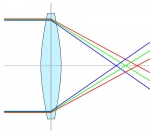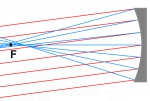Paracorr-Newtonian for Visual and Imaging to f/3! Part 1


Invented from lenses used to make eyeglasses, refractors were the first telescopes when introduced in the 1600s. However, the early refractor builders could not avoid building scopes that displayed color fringes (chromatic aberration) around bright objects. It was Sir Isaac Newton (1642–1727) who figured out that white light is composed of different wavelengths that we see as colors. Each wavelength will refract (bend) by a different amount as it passed through the refractor’s objective glass. The longest wavelengths (red) refract less while the shorter wavelengths (blue) refract more. As a result, the red component of the image focuses behind the blue component. Pinpoint images and higher magnification were out of the question with these primitive scopes. Even after the cause of chromatic aberration was revealed, refractor builders didn’t have the glass types and manufacturing skills to counter it for another century. Sir Newton, however, had an idea to build a second type of telescope that avoided refraction: a reflector.

CC BY 4.0)
Sir Newton realized the advantage of using the principles of reflection to focus light and eliminate chromatic aberration. So, he built the first working reflecting telescope. In his Newtonian scope, the light was focused using a curved mirror instead of a lens. All wavelengths of light reflect at the same angle for a given spot on the mirror. Thus there was no refraction of light until the eyepiece was reached. To simplify construction, Newton employed a spherical mirror.

Spherical mirrors have a major drawback though: the light bouncing off the mirror’s edge focuses closer to the mirror than light reflecting near the center (this is known as “spherical aberration”). For Newton’s small-diameter scope this was not a big problem. For larger diameter mirrors, the result would be a blurry image. The solution was to shape the mirror surface into a parabola instead of a sphere. At the center of the field, a perfectly made parabolic mirror will focus light falling on the mirror from infinity to a point. The only thing that held back the reflecting scope from popular adoption was the method of making mirrors: for 200-years they were made of speculum metal that was difficult to work with and rapidly tarnished. It wasn’t until the mid-19th century that glass-ground mirrors with metal coatings were developed.

When ground-glass mirrors became the norm, reflectors quickly became the dominant type of large observatory telescope. Amateurs began to adopt the reflecting scope and legions of early-20th century amateurs ground out their first 6″, f/8 Newtonian telescope. The adoption of the Dobsonian mount for the Newtonian telescope in the 1970s allowed for larger mirrors on a simple, lightweight mount. Faster focal-ratio (smaller f/#) mirrors — having a shorter focal length for a given mirror diameter — were explored to prevent the telescope tube from becoming too long. This exposed an aberration not seen with slower Newtonian scopes: coma.

As mentioned earlier, stars at or near the optical axis will focus to a point when reflected off a parabola. However, stars away from the center of the field of view (off-axis) take on a very different shape because they are not “seeing” the paraboloid symmetrically like the “on-axis” bundle. Individual rays in an “off-axis” parallel bundle of rays entering the telescope will reflect off the parabolic shape at different angles from each other depending on the height at which each ray hits the mirror. Instead of creating a round star image, the different focal points cause the star to form a “comet-like” shape that gets wider toward the edge-of-field. The effect gets worse the further off-axis the star is from the center of the field. The easy solution is to keep moving an object of interest into the center of the field and ignore the edges.
To rescue fast Dobsonian telescopes from the curse of coma, Tele Vue’s Al Nagler designed the original Paracorr (Parabola corrector) in 1989 for f/4.5 and slower “DobNewt” telescopes. Al’s design goals were “to achieve the same field quality for parabolas as reached by my 4-element refractor designs.”
While Paracorr was not the first coma corrector, Al noted that “Existing coma correctors seemed to be limited in color and spherical aberration corrections and convenience in use.” Paracorr is completely color-free, center to edge, flattens the field, and installs like a Barlow. To minimize focus change, Paracorr introduces a slight, 15% Barlow effect. Now with Paracorr, Newton’s perfect reflecting telescope was complete! “No more finding the ‘sweet spot’ of focus,” read Tele Vue’s advertising for the new Paracorr, “The entire field is your ‘sweet spot!'”

By 2009 mirrors had gotten decidedly faster than they were in the late ’80s and some of our eyepieces had significantly different field stop locations. We decided to re-optimize the Paracorr with a new Type-2 design. This new Paracorr Type-2 inserted into an f/3 Dobsonian made the stars appear as coma-free as a native f/12 mirror. The new Tunable Top on this model also provided additional travel to allow ideal correction for the 31mm Nagler Type 5 and 21mm Ethos eyepieces. In 2014 the 3″ BIG Paracorr Type-2 was introduced to satisfy imaging needs with the new breed of fast mirrors and large CCD chips. As shown in the above chart, The Type-2 Paracorr reduces the RMS star spot size even at the edge of the field of a 21mm Ethos to below the 3-micron diffraction limit for an f/3.5 mirror. Without the Type-2 Paracorr, the RMS spot size would be about 40-times larger! This latest Paracorr heralds a revolution in the development of mega diameter, yet, “ladderless” Dobs with larger sharp fields of view than previously practical. For a history of super-short Newtonian telescopes with large apertures and how the Paracorr Type-2 played a role in their development, read The new Dobsonian revolution article in Astronomy magazine by Michael E. Bakich.

Paracorr Spot Diagrams
The following diagrams quantify how well the Paracorr-Type 2 series banishes coma for various focal ratio parabolic reflectors. For each f-ratio shown, the curve in the diagrams indicates the RMS radius of a star image in microns from center to the edge of the field with the 2″ Paracorr Type-2 installed. The horizontal line for each given f-ratio — the Airy Disc Radius — is the calculated radius of a distant star image. Notice that the theoretical spot size with the Paracrorr Type-2 is below the Airy Disc radius in the fastest mirrors. Except for the furthest reaches of the field in an f/3 scope, the spot size is still diffraction limited. Just compare the spot size at the same point in the field with an uncorrected parabola — see the diagram on the right side labeled Spot Sizes for Parabola Alone.


Paracorr – Newtonian Versus the Exotics for Imaging
We’ve all looked at those adverts for exotic imaging scopes costing 5-digits USD or more. Could a large, fast Newtonian with 3″ BIG Paracorr Type-2 compete against these for full-frame or larger imaging? We present a recent survey of various 8″ to 12″ scope designs for comparison. Objective size and price are approximate for brand-name scopes. First-up are scopes slower than f/6.
- Aplanatic flat-field Schmidt-Cassegrain control field curvature and off-axis star coma but are relatively narrow field due to their long focal lengths and are quite slow at f/10 or slower. A brand-name 11″ is about $3.5k
- Dall-Kirkham Cassegrain scopes are slow in order to minimize off-axis coma. An 8.25″ f/11.5 example costs about $3k.
- Ritchey-Chrétien scopes deliver coma, spherical and chromatic aberration-free results just like a well-designed Paracorr-Newtonian. However, they are generally slower f/8 instruments. The price of a 10″ model will also set you back around $3k.
- CDK Corrected Dall-Kirkham benefits include coma and astigmatism correction and a flat field. A 12.5″ f/8 can be had for $10k.
We found two exotics that can best the speed of a fast, Paracorr corrected, Newtonian and we list them next.
- Riccardi-Honders astrographs of 12″ diameter at f/3 can be had for $26k.
- The Rowe-Ackermann Schmidt is a catadioptric scope with many optical interfaces: a Schmidt corrector, a primary mirror, a lens group, and an optical window. While 11″ ones can be found as fast as f/2.2, the price of all that glass and speed brings a $3.5k price tag.
So how much will a large Newtonian set you back (unless you already own one!) and how will image quality compare to the exotic contenders when used with Paracorr? Here’s a quote from an imaging review of our 3″ BIG Paracorr Type-2 incorporated into a 12″ f/5 Dob — the emphasis is ours.
During my years of testing astronomy equipment, I’ve worked with some of the world’s finest telescopes designed for astrophotography. I’ve used telescopes made by Officina Stellare, PlaneWave, Takahashi, and Tele Vue, as well as top-of-the-line equipment from Celestron, Meade, Star-Watcher, Stellarvue, and others. The astrophotos with this review, however, weren’t made with any of them. Rather, they were taken with a 12-inch Meade LightBridge Dobsonian that I bought used for $500. All I did was add Tele Vue’s new Big Paracorr Type-2 coma corrector to the scope and, Voila, I had imaging performance that was on par with the best astrographs I’ve tested.
di Cicco, Dennis. “Tele Vue’s Big Paracorr Type-2”. Sky & Telescope (April 2015). pp72-76.
Dennis used a camera with the huge KAF-16803 sensor that consists of a 4,096 x 4,096 array of nine-micron pixels, 36.9mm x 36.9mm in size with 52mm diagonal. This is exactly what the 3″ BIG Paracorr is designed for and he captured 1.70° of sky on the diagonal. With this setup, he was easily able to frame extended objects such as all the bright stars of the Pleiades open cluster. That’s much more sky than any of the slow scopes in the first exotic grouping can manage.
Since most scopes aren’t designed for 3″ focuser accessories, it was a DIY project to fit a Paracorr onto the scope and convert it for attachment to a heavy-duty equatorial mount for guided imaging. Dennis swapped in a 4″ secondary mirror and a 3″ focuser to fully illuminate the camera’s large chip and attach the 3″ BIG Paracorr. In our estimation, the bottom-line cost of the project was below any of the scopes mentioned above if you could get them with 12″ diameter clear aperture!
For additional images and comments about converting the scope, see Dennis’ Tele Vue’s 3-inch Paracorr article online.

Next week, in Part II of this blog post, we’ll cover which of the three current Paracorr models to use for your application.
- Tele Vue Paracorr Type-2 on our website (mobile site).
- Tele Vue Tunable-Top Eyepiece Table (mobile site).


